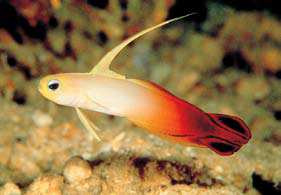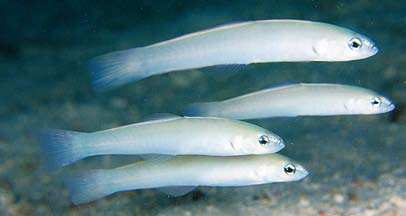PTERELEOTRIDAE
Dart Gobies
By Koichi Shibukawa
 Nemateleotris decora |
 Nemateleotris magnifica |
 Parioglossus formosus |
 Parioglossus palustris |
 Parioglossus philippinus |
 Ptereleotris arabica |
 Ptereleotris evides |
 Ptereleotris microlepis |
|
Small to moderate-sized (up to ca. 18 cm SL, commonly to 10 cm), bottom-orianted free swimming fishes. Body elongate, sometimes highly compressed; head more or less compressed; no pored or tubed lateral-line scales on body. Teeth conical, forming some or several rows in each jaw; minute sensory papillae developed on head (and few on body and caudal fin), forming transverse or longitudinal rows; five branchiostegal rays. Usually two dorsal fins (continuous in one species of Ptereleotris), first one with IV-VI flexible spines and second one with single flexible spine and 9-39 soft rays; anal fin with single flexible spine and 14-37 soft rays; pectoral fin with 10-25 soft rays; pelvic fins separated, with single spine and 3-5 soft rays in each; caudal fin rounded, truncate or often emarginate. Scales small cycloid (except for Nemateleotris and some species of Ptereleotris with ctenoid scales), mostly embedded and nonimbricate. Color: variable. Similar families occurring in the area. Blenniidae: teeth incisorlike, forming single row in each jaw. Eleotridae: six branchiostegal rays; head subcylindrical or rather depressed in many species; scales imbricate in most species. Gobiidae: pelvic fins usually united medially; scales, if present, imbricate in most species. Remarks. Typically found in coral reefs and brackish estuaries. Several species often treated as aquarium fish. |

|
|